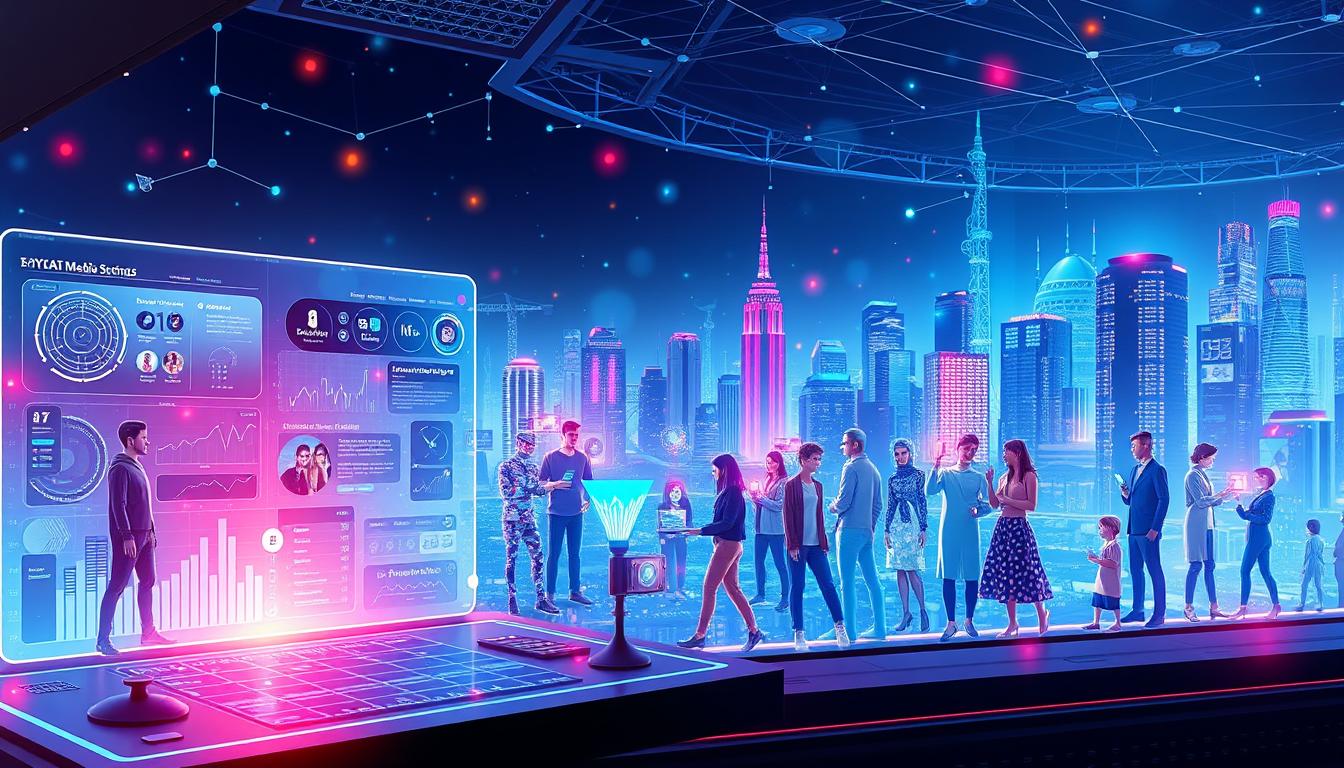Blog
Top Social Media Trends Dominating 2026

The world of social media is constantly evolving, and 2026 is shaping up to be an exciting year. As we dive into the latest developments, it’s clear that new technologies and shifting user behaviors are driving the trends that will dominate the landscape.
The latest advancements in social media are not just about new features; they’re about creating a more immersive and engaging experience for users. As we explore these emerging trends, we’ll gain insights into what’s new and what’s next in the world of online interactions.
Key Takeaways
- New technologies are driving the latest social media trends.
- Shifting user behaviors are shaping the social media landscape.
- Emerging trends are creating a more immersive user experience.
- Social media platforms are evolving to meet user needs.
- The future of social media is centered around engagement and interaction.
The Evolution of Social Media Landscape
The journey of social media from Web 2.0 to the anticipated Web 5.0 is redefining online interactions. This evolution is not just about technological advancements but also about how these changes impact our digital connections.
From Web 2.0 to Web 5.0: The Journey So Far
The transition from Web 2.0 to Web 5.0 represents a significant shift in the social media landscape. Web 2.0 introduced user-generated content, while Web 3.0 brought semantic web capabilities. Now, as we approach Web 5.0, we’re seeing the emergence of a more intelligent and interactive internet.
Why 2026 Represents a Pivotal Year for Digital Connection
2026 is poised to be a landmark year for digital connection due to the convergence of several technological advancements. As noted by industry expert, “The future of social media lies in its ability to seamlessly integrate with our daily lives, making digital connections feel more personal and intuitive.”
This convergence is expected to revolutionize how businesses approach their digital strategy, focusing more on personalized marketing and immersive experiences.
Key Drivers Reshaping How We Connect Online
Several key drivers are reshaping the social media landscape, including advancements in AI, the rise of the metaverse, and increased focus on privacy. These drivers are transforming how we connect online, making interactions more immersive and secure.
| Driver | Impact on Social Media |
|---|---|
| AI Advancements | Personalized content curation and generation |
| Metaverse Rise | Immersive virtual worlds for social interaction |
| Privacy Focus | Enhanced security and user control over data |
As we move towards 2026, understanding these drivers will be crucial for businesses to develop effective marketing strategies that resonate with their audience.
AI-Powered Content Creation and Curation
With advancements in AI technology, social media platforms are on the cusp of a content creation revolution in 2026. The integration of AI in content creation and curation is transforming how we interact with social media, making it more personalized and engaging.
Neural Generation of Personalized Media Streams
AI algorithms are now capable of generating personalized media streams that cater to individual user preferences. This is achieved through complex neural networks that analyze user behavior, preferences, and interactions to create a unique content feed.
Key Features of Neural Generation:
- Personalized content curation based on user behavior
- Real-time content generation
- Enhanced user engagement through tailored media streams
AI Collaboration Tools for Creators
AI is not only changing how content is consumed but also how it’s created. AI collaboration tools are emerging as a significant trend, enabling creators to produce high-quality content more efficiently.
| Feature | Description | Benefit |
|---|---|---|
| Content Suggestions | AI-driven suggestions for content improvement | Enhanced creativity and relevance |
| Automated Editing | AI-powered editing tools for faster content refinement | Increased productivity |
| Collaborative Platforms | AI-facilitated collaboration between creators | Better teamwork and idea sharing |
Ethical Boundaries in Synthetic Media
As AI-generated content becomes more prevalent, ethical considerations come to the forefront. The use of synthetic media raises questions about authenticity, transparency, and the potential for misinformation.
Disclosure Requirements for AI-Generated Content
To address these concerns, there’s a growing need for disclosure requirements that mandate the labeling of AI-generated content. This transparency is crucial for maintaining trust and integrity in the digital ecosystem.
The future of AI in social media is not just about technological advancement but also about ensuring that these advancements are used responsibly.
Immersive Social Experiences: The Metaverse Evolution
Immersive social experiences are redefining how we interact online, with the metaverse at the forefront of this digital transformation. The metaverse is not just a virtual space; it’s an evolving ecosystem that integrates various technologies to create a more interactive and engaging social experience.
Persistent Virtual Worlds as Social Hubs
Virtual worlds within the metaverse are becoming persistent social hubs where users can gather, interact, and collaborate in real-time. These environments are designed to be immersive, allowing users to engage in activities that range from socializing to participating in events and experiences.
Cross-Platform Avatar Identities
The development of cross-platform avatar identities enables users to maintain a consistent digital presence across different virtual environments and social platforms. This continuity is crucial for building a robust digital identity and enhancing the overall user experience.
Physical-Digital Hybrid Events and Gatherings
The metaverse is also facilitating physical-digital hybrid events, where participants can engage in activities that blend the physical and digital worlds. This fusion is achieved through advanced technologies that allow for seamless interaction between different realms.
Sensory Integration Technologies
A key aspect of creating immersive experiences in the metaverse is the integration of sensory integration technologies. These technologies aim to stimulate multiple senses, providing a more realistic and engaging experience. By incorporating sensory feedback, the metaverse can offer a more immersive and interactive environment.
The evolution of the metaverse represents a significant shift in how we approach social interactions online. By leveraging immersive technologies and creating more interactive environments, the metaverse is poised to revolutionize the future of digital social experiences, aligning with innovative digital strategy and marketing approaches.
Voice and Gesture-Controlled Social Interfaces
The future of social media is being shaped by voice and gesture-controlled interfaces, revolutionizing how we interact online. As technology advances, we’re seeing a significant shift towards more intuitive and accessible ways of engaging with social media platforms.
Ambient Computing in Social Media
Ambient computing is changing the social media landscape by enabling users to interact with platforms through voice commands and gestures. This technology allows for a more seamless and integrated experience, making it easier to navigate and engage with content.

Neural Interface Early Adoptions
Neural interfaces represent a cutting-edge development in social media interaction. Early adopters of this technology are exploring new ways to connect and communicate, potentially transforming the social media experience.
Accessibility Transformations Through New Input Methods
The introduction of voice and gesture-controlled interfaces is significantly improving accessibility in social media. These new input methods are enabling users with disabilities to engage more easily with online communities.
| Feature | Benefit | Impact |
|---|---|---|
| Voice Control | Easier navigation | Increased accessibility |
| Gesture Control | More intuitive interaction | Enhanced user experience |
| Neural Interfaces | Direct brain-computer interaction | Revolutionary communication methods |
As voice and gesture-controlled social interfaces continue to evolve, we can expect to see even more innovative and accessible ways of interacting with social media. This trend is set to reshape the digital landscape, making online interactions more natural and inclusive.
Decentralized Social Networks and Web3 Integration
Decentralized social networks are redefining the way we interact online, bringing about a new era of user-centric platforms. This shift is part of the broader digital strategy that is transforming the social media landscape in 2026.
User-Owned Social Platforms and Governance
One of the key trends in decentralized social networks is the emergence of user-owned platforms. These platforms allow users to have control over their data and content, ensuring privacy and security. The governance models of these platforms are also being designed to be more democratic, giving users a say in decision-making processes.
Digital Asset Communities and Social Tokens
Decentralized social networks are also fostering the creation of digital asset communities. These communities are built around social tokens, which are used to reward users for their contributions. This model encourages engagement and creates a sense of community among users.
Content Monetization Through Blockchain
Blockchain technology is enabling new ways of content monetization on decentralized social networks. Creators can now tokenize their content and sell it directly to their audience, cutting out intermediaries. This direct-to-consumer model is becoming a significant trend in the creator economy.
Interoperability Between Traditional and Decentralized Networks
For decentralized social networks to reach their full potential, interoperability with traditional networks is crucial. Efforts are being made to develop standards that allow for seamless interaction between different platforms, ensuring that users can move their data and connections freely.
The integration of Web3 technologies with social media is a significant step towards creating a more open and user-centric internet. As these trends continue to evolve, we can expect to see even more innovative applications of decentralized technologies in the social media space.
Social Media Trends Reshaping Marketing Strategies
Social media continues to evolve, bringing with it new trends that are reshaping the way marketers approach their strategies in 2026. The dynamic nature of social media platforms demands that marketers stay agile and adapt to the latest developments.
Hyper-Contextual Advertising Models
One of the significant trends is the rise of hyper-contextual advertising models. These models use advanced data analytics and AI to deliver highly targeted advertisements based on a user’s current context, including location, activity, and preferences.
Key Features of Hyper-Contextual Advertising:
- Real-time data processing
- Personalized ad content
- Location-based targeting
Community-Centric Brand Building
Another trend reshaping marketing strategies is community-centric brand building. Brands are now focusing on creating and nurturing communities around their products or services, fostering loyalty and engagement.
Benefits of Community-Centric Brand Building:
- Increased brand loyalty
- Enhanced customer engagement
- Valuable feedback and insights
Value Exchange Marketing
Value exchange marketing is gaining traction as consumers increasingly expect value in return for their data and attention. This approach involves offering consumers relevant, valuable content or services in exchange for their engagement.
Predictive Analytics for Trend Anticipation
Predictive analytics plays a crucial role in anticipating trends and enabling marketers to stay ahead of the curve. By analyzing historical data and current patterns, predictive analytics can forecast future trends and consumer behaviors.
| Trend | Description | Marketing Impact |
|---|---|---|
| Hyper-Contextual Advertising | Targeted ads based on user context | Increased ad effectiveness |
| Community-Centric Brand Building | Fostering communities around brands | Enhanced brand loyalty |
| Value Exchange Marketing | Offering value in exchange for engagement | Improved consumer engagement |
By understanding and leveraging these trends, marketers can develop more effective strategies that resonate with their target audiences and drive meaningful engagement.
Privacy-First Social Experiences
With growing concerns over data privacy, social media is adapting to prioritize user confidentiality. This shift is driven by the need for more secure and private online interactions.
User-Controlled Data Vaults
User-controlled data vaults are emerging as a key feature in privacy-first social experiences. These vaults allow users to manage their data more effectively, deciding who can access their information and under what circumstances.
Zero-Knowledge Proof Social Interactions
Zero-knowledge proof social interactions are another significant development. This technology enables users to interact on social platforms without revealing their identity or other sensitive information, thus enhancing privacy.
Global Regulatory Framework Impacts
Global regulatory frameworks are also playing a crucial role in shaping privacy-first social experiences. Regulations are being put in place to ensure that social media platforms adhere to strict data privacy standards.
Privacy as a Premium Feature
The emphasis on privacy is turning it into a premium feature that users are willing to pay for. This shift is changing the way social media platforms operate, with many now offering enhanced privacy features as part of their premium services.
In conclusion, privacy-first social experiences are redefining the social media landscape, driven by technological innovations and regulatory changes. As users become more aware of their digital rights, the demand for privacy-centric social platforms is expected to grow.
Social Commerce 3.0
As we step into 2026, the landscape of social commerce is undergoing a significant transformation. Social Commerce 3.0 represents the latest evolution in online shopping, integrating advanced technologies to create more immersive, interactive, and seamless experiences.
Immersive Shopping Environments
The development of immersive shopping environments is a key feature of Social Commerce 3.0. Brands are now leveraging Virtual Reality (VR) and Augmented Reality (AR) to create engaging shopping experiences that simulate the physical store environment online.
Virtual and Augmented Try-Before-You-Buy
One of the most significant advancements in Social Commerce 3.0 is the virtual try-before-you-buy feature. This technology allows consumers to try products virtually, reducing the uncertainty associated with online purchases and enhancing customer satisfaction.
Social Purchasing Without Platform Boundaries
Social Commerce 3.0 is also characterized by the ability to make purchases without leaving the social media platform. This seamless integration is facilitated by cross-platform payment systems and universal social identities.
Cryptocurrency and Alternative Payment Integration
The integration of cryptocurrency and alternative payment methods is becoming increasingly prevalent in Social Commerce 3.0. This shift is driven by the need for more flexible and secure payment options.
| Feature | Description | Benefit |
|---|---|---|
| Immersive Shopping | VR/AR environments for shopping | Enhanced customer engagement |
| Virtual Try-Before-You-Buy | Try products virtually | Reduced return rates |
| Cross-Platform Payments | Seamless payment systems | Increased conversion rates |

As social commerce continues to evolve, it’s clear that technologies like VR, AR, and cryptocurrency will play a pivotal role in shaping the future of online shopping. By embracing these advancements, businesses can create more engaging, secure, and personalized shopping experiences.
Mental Health and Digital Wellbeing Innovations
Digital wellbeing is taking center stage in 2026, with a focus on mental health innovations that are both impactful and accessible. As technology continues to evolve, it’s playing an increasingly crucial role in supporting mental health through various digital means.
Emotional Intelligence Algorithms
Emotional intelligence algorithms are being developed to better understand and respond to users’ emotional states. These algorithms can analyze vast amounts of data to provide personalized support and interventions.
- Enhanced emotional recognition capabilities
- Personalized mental health support
- Early detection of mental health issues
Cognitive Load Management Tools
Cognitive load management tools are designed to help users manage the overwhelming amount of information they encounter online. By streamlining content and reducing digital clutter, these tools promote a healthier digital experience.
Key features include:
- Content filtering and prioritization
- Digital detox features
- Customizable notification systems
Positive Content Promotion Systems
Positive content promotion systems aim to foster a more supportive online environment by promoting uplifting and positive content. This shift towards positivity is crucial for enhancing digital wellbeing.
Therapeutic Digital Spaces
Therapeutic digital spaces are being created to provide safe and supportive online environments. These spaces leverage technology to offer various forms of therapy and support, making mental health resources more accessible.
The benefits of therapeutic digital spaces include:
- Increased accessibility to mental health resources
- Anonymity and comfort for users seeking help
- A wide range of therapeutic options
As we continue to navigate the digital landscape, innovations in mental health and digital wellbeing will play a vital role in shaping a healthier online community. By embracing these trends and technologies, we can work towards a more supportive and positive digital environment.
Niche Community Platforms and Vertical Networks
As we dive into 2026, the social media landscape is becoming increasingly fragmented, giving rise to niche community platforms. This shift is driven by the growing demand for specialized online environments that cater to specific interests, industries, and values.
Industry-Specific Social Ecosystems
Industry-specific social ecosystems are flourishing, providing professionals with dedicated spaces to network, share knowledge, and collaborate. For instance, platforms like GitHub for developers and Behance for creatives have become essential hubs for their respective communities.
Micro-Communities Based on Shared Values
Micro-communities centered around shared values are also on the rise. These communities, often formed around social causes or hobbies, allow individuals to connect with like-minded people and engage in meaningful discussions. The sense of belonging and purpose that these communities foster is becoming increasingly important in the digital age.
The Fragmentation of Mass Social Media
The rise of niche platforms is contributing to the fragmentation of mass social media. As users seek more tailored experiences, the once-dominant platforms are losing their grip on the market. This fragmentation is leading to a more diverse social media landscape.
Professional Development-Focused Networks
Professional development-focused networks are a significant aspect of this trend. Platforms like LinkedIn are evolving to include more specialized features, while new entrants are focusing on specific professions or industries. For example, a platform dedicated to healthcare professionals might offer continuing education resources and networking opportunities.
| Platform Type | Target Audience | Key Features |
|---|---|---|
| Industry-specific | Professionals in a specific industry | Networking, knowledge sharing, collaboration tools |
| Micro-communities | Individuals with shared values or interests | Discussion forums, event planning, resource sharing |
| Professional development | Professionals seeking career advancement | Continuing education, mentorship, job listings |
As noted by
“The future of social media lies in its ability to foster meaningful connections and communities.”
The trend towards niche community platforms and vertical networks is a step in this direction, offering users more focused and engaging online experiences.
Cross-Platform Integration and Universal Social Identities
Cross-platform integration is emerging as a key trend in 2026, transforming how we interact online. This shift is driven by the need for a more cohesive and streamlined digital experience across various social media platforms.
Portable Content and Audience Relationships
The concept of portable content allows creators to share their work across multiple platforms without having to reformat or repost it manually. This not only saves time but also ensures consistency in the content being shared.
Moreover, audience relationships are becoming more portable, enabling creators to maintain their follower base even when they switch platforms. This is crucial for building a loyal community.
Unified Creator Analytics and Monetization
One of the significant challenges creators face today is the lack of unified analytics across platforms. In 2026, we can expect to see more unified creator analytics that provide a comprehensive view of their performance across different social media sites.
Additionally, monetization strategies are becoming more integrated, allowing creators to earn from their content across various platforms seamlessly.
Standardized Social API Frameworks
The development of standardized social API frameworks is crucial for facilitating cross-platform integration. These frameworks enable different social media platforms to communicate effectively, ensuring a smooth user experience.
Digital Identity Verification and Reputation Systems
A significant aspect of universal social identities is digital identity verification. This process ensures that users’ identities are verified across platforms, enhancing trust and security.
Reputation systems are also being integrated into these universal identities, allowing users to carry their reputation across different platforms. This can significantly impact how users interact and build relationships online.
Conclusion: Navigating the Social Media Future of 2026
As we look ahead to 2026, the social media landscape is poised for significant transformations. The trends shaping the industry, from AI-powered content creation to immersive social experiences, are redefining how we connect and interact online.
Understanding these social media trends is crucial for developing effective marketing strategies and staying ahead in the digital landscape. By embracing the latest advancements in social media, businesses and individuals can enhance their digital strategy and remain competitive.
The future of social media is not just about technological advancements; it’s also about creating meaningful connections and experiences. As we navigate this evolving landscape, it’s essential to stay informed and adapt to the changing trends and technologies that are shaping the world of social media.

